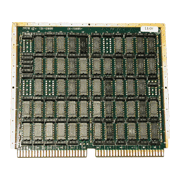This was the high-end model of the NEAC Series 2200 announced in November 1968. It was an ultra-large time-sharing system developed independently by NEC.
Features of the Model 700:
1) It was suitable for large time-sharing systems (TSS)
The Model 500 was delivered for the MAC System of Osaka University, and a practical time-sharing system was developed for the first time in Japan. In a time-sharing system, programs can be created and executed interactively from multiple subscriber terminals, and the Model 700 made it possible to provide a larger-scale and higher-speed time-sharing system.
2) Multitask control of up to 20 tasks was enabled by using a large-scale OS called MOD4
3) It was the largest and fastest Japanese produced computer of the time
Using high-speed CML ICs, the system achieved a fixed point addition/subtraction time of 0.5 microseconds per 8characters, and a floating point addition/subtraction time of 0.8 microseconds per 8characters. The main memory employed a magnetic core memory with cycle time of 0.5 microseconds. A maximum memory capacity of 2megacharacters was attained, and cache memory was also used (although the amount of cache was small). Scan paths for testing and diagnosis were provided for the first time in the world in flip-flop ICs, and these were used to automatically generate date for package testing and system diagnosis. As external memory, the system had a set of magnetic disks with 294megacharacters per 16spindles.
| 700 | 500 | |
|---|---|---|
| Announcement date | November 1968 | May 1965 |
| Number of arithmetic processing units | Max. 2 | 1 |
| Memory capacity (char.) | Max. 2,097k/arithmetic processing unit | Max. 524k |
| Main memory cycle time | 0.5µs/8char. | 1.5µs/8char. |
| Average instruction execution time | - | 5.7µs |
| Fixed point operation time | 0.5µs/8char. | - |
| Floating point operation time | 0.8µs/8char. | - |
| Input/Output simultaneous operation | Max. 24 | Max. 16 |
| Number of input/output trunks | Max. 128 | Max. 64 |
| CPU element | IC | |
| Memory element | Magnetic core | |



